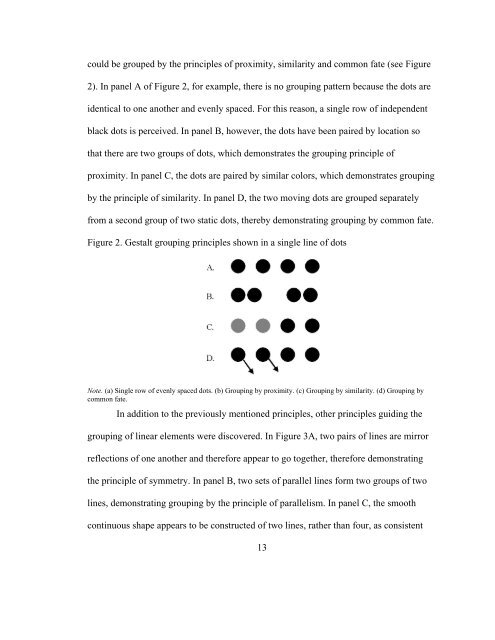The Use of Iambic Pentameter in the
The Use of Iambic Pentameter in the
The Use of Iambic Pentameter in the
You also want an ePaper? Increase the reach of your titles
YUMPU automatically turns print PDFs into web optimized ePapers that Google loves.
could be grouped by <strong>the</strong> pr<strong>in</strong>ciples <strong>of</strong> proximity, similarity and common fate (see Figure<br />
2). In panel A <strong>of</strong> Figure 2, for example, <strong>the</strong>re is no group<strong>in</strong>g pattern because <strong>the</strong> dots are<br />
identical to one ano<strong>the</strong>r and evenly spaced. For this reason, a s<strong>in</strong>gle row <strong>of</strong> <strong>in</strong>dependent<br />
black dots is perceived. In panel B, however, <strong>the</strong> dots have been paired by location so<br />
that <strong>the</strong>re are two groups <strong>of</strong> dots, which demonstrates <strong>the</strong> group<strong>in</strong>g pr<strong>in</strong>ciple <strong>of</strong><br />
proximity. In panel C, <strong>the</strong> dots are paired by similar colors, which demonstrates group<strong>in</strong>g<br />
by <strong>the</strong> pr<strong>in</strong>ciple <strong>of</strong> similarity. In panel D, <strong>the</strong> two mov<strong>in</strong>g dots are grouped separately<br />
from a second group <strong>of</strong> two static dots, <strong>the</strong>reby demonstrat<strong>in</strong>g group<strong>in</strong>g by common fate.<br />
Figure 2. Gestalt group<strong>in</strong>g pr<strong>in</strong>ciples shown <strong>in</strong> a s<strong>in</strong>gle l<strong>in</strong>e <strong>of</strong> dots<br />
Note. (a) S<strong>in</strong>gle row <strong>of</strong> evenly spaced dots. (b) Group<strong>in</strong>g by proximity. (c) Group<strong>in</strong>g by similarity. (d) Group<strong>in</strong>g by<br />
common fate.<br />
In addition to <strong>the</strong> previously mentioned pr<strong>in</strong>ciples, o<strong>the</strong>r pr<strong>in</strong>ciples guid<strong>in</strong>g <strong>the</strong><br />
group<strong>in</strong>g <strong>of</strong> l<strong>in</strong>ear elements were discovered. In Figure 3A, two pairs <strong>of</strong> l<strong>in</strong>es are mirror<br />
reflections <strong>of</strong> one ano<strong>the</strong>r and <strong>the</strong>refore appear to go toge<strong>the</strong>r, <strong>the</strong>refore demonstrat<strong>in</strong>g<br />
<strong>the</strong> pr<strong>in</strong>ciple <strong>of</strong> symmetry. In panel B, two sets <strong>of</strong> parallel l<strong>in</strong>es form two groups <strong>of</strong> two<br />
l<strong>in</strong>es, demonstrat<strong>in</strong>g group<strong>in</strong>g by <strong>the</strong> pr<strong>in</strong>ciple <strong>of</strong> parallelism. In panel C, <strong>the</strong> smooth<br />
cont<strong>in</strong>uous shape appears to be constructed <strong>of</strong> two l<strong>in</strong>es, ra<strong>the</strong>r than four, as consistent<br />
13

















